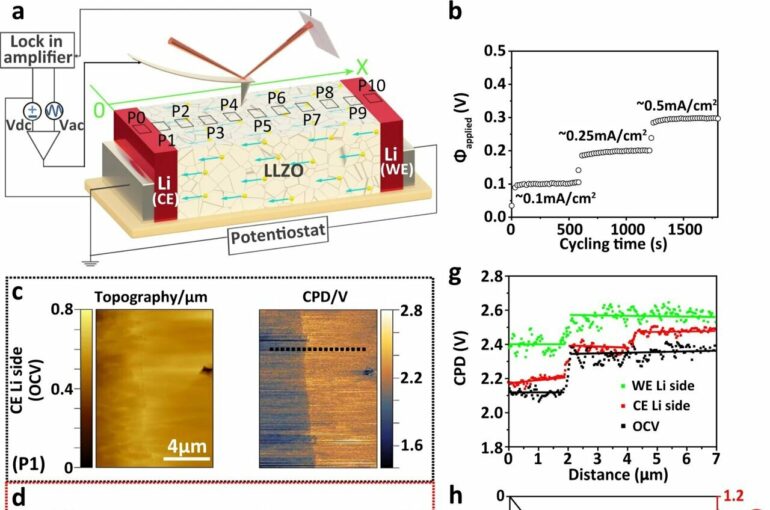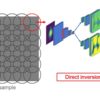They are considered the “Holy Grail” of battery research: so-called “solid-state batteries.” They no longer have a liquid core, as is the case with today’s batteries, but consist of a solid material. This leads to several advantages: Among other things, these batteries are more difficult to ignite and can also be manufactured on a miniature scale.
Scientists at the Max Planck Institute for Polymer Research have now turned their attention to the life cycle of such batteries and targeted processes that reduce it. With their findings, more durable solid-state batteries could be realized in the future.
Whether in an e-car, cell phone, or cordless screwdriver, many devices used on a daily basis now use rechargeable batteries. However, the trend also has its downsides. For example, certain cell phones were banned from being carried on airplanes, or e-cars caught fire. Modern commercial lithium ion batteries are sensitive to mechanical stress.
So-called “solid-state batteries” could provide a remedy. These no longer contain a liquid core—the so-called electrolyte—but consist entirely of solid material, e.g. ceramics ionic conductor. As a result, they are mechanically robust, non-flammable, easy to miniaturize and insensitive to temperature fluctuations.
But solid-state batteries show their problems after several charging and discharging cycles: While the positive and negative poles of the battery are still electrically separated from each other at the beginning, they are eventually electrically connected to each other by internal battery processes: “Lithium dendrites” slowly grow in the battery.
These lithium dendrites grow step by step during each charging process until the two poles are connected. The result: the battery is short circuited and “dies.” So far, however, the exact physical processes that take place in this process are not yet well understood.
A team led by Rüdiger Berger from Hans-Jürgen Butt’s department has now tackled the problem and used a special microscopy method to investigate the processes in more detail. They investigated the question of where the lithium dendrites start to grow. Is it like in a flowstone cave where stalactites grow from the ceiling and stalagmites from the floor until they join in the middle and form a so-called “stalagnate”?
There is no top and bottom in a battery—but do dendrites grow from the negative to the positive pole or from the positive to the negative pole? Or do they grow equally from both poles? Or are there special places in the battery that lead to nucleation and then dendritic growth from there?
Rüdiger Berger’s team looked in particular at so-called “grain boundaries” in the ceramic solid electrolyte. These boundaries are formed during the production of the solid layer: The atoms in the crystals of the ceramic are basically very regularly arranged. However, due to small, random fluctuations in crystal growth, line-like structures are formed where the atoms are arranged irregularly—a so-called “grain boundary.”
These grain boundaries are visible with their microscopy method—”Kelvin Probe Force Microscopy”—in which the surface is scanned with a sharp tip. Chao Zhu, a Ph.D. student working with Rüdiger Berger says, “If the solid-state battery is charged, the Kelvin Probe Force Microscopy sees that electrons accumulate along the grain boundaries—especially near the negative pole.” The latter indicates that the grain boundary not only changes the arrangement of the atoms of the ceramics, but also their electronic structure.
Due to the accumulation of electrons—i.e. negative particles—positively charged lithium ions traveling in the solid electrolyte can be reduced into metallic lithium. The result: lithium deposits and lithium dendrites form. If the charging process is repeated, the dendrite will continue to grow until finally the poles of the battery are connected. The formation of such initial stages for dendrite growth was only observed at the negative pole—also observed only at this pole. No growth was observed at the opposite positive pole.
The scientists hope that with a precise understanding of the growth processes, they will also be able to develop effective ways to prevent or at least limit growth at the negative pole, so that in the future the safer lithium solid-state batteries can also be used in broadband applications.
The paper is published in the journal Nature Communications.
More information:
Chao Zhu et al, Understanding the evolution of lithium dendrites at Li6.25Al0.25La3Zr2O12 grain boundaries via operando microscopy techniques, Nature Communications (2023). DOI: 10.1038/s41467-023-36792-7
Provided by
Max Planck Society
Citation:
Stalactites and stalagmites in the battery? New research could lead to longer-lasting batteries (2023, March 16)



